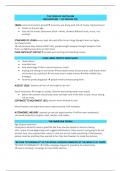1
THE CRISIS OF CAPITALISM
BACKGROUND – THE ROAING 20S
1920S = time of economic growthà economy was doing well, lots of money, big businesses
• known as the jazz age.
• time of first moves (they were black + white, showed different lands, music, not
actually)
STANDARD OF LIVING = very high à could afford nicer things (bought items on higher
purchase/credit)
à only because they entered WW1 late, people bought weapons bought weapons from
them, no fighting was done on their land.
PURE CAPITALIST SYSTEM à people were earning and spending money.
HOW LARGE PROFITS WERE MADE:
• cheap labour
• assembly lines
• took advantage of their natural resources (coal)
• trading and selling on wall street à borrowed money to buy shares, sold shares when
prices were up, paid back à very easy way to make money à white middle class
emerged.
• factories producing goods à people need to keep buying them.
AUGUST 1929: ‘anyone can be rich and ought to be rich’.
Social revolution à change in society. Women were being made more equal
• before this woman should stay home and take care of the kids, no job, not as strong,
not as smart.
SUFFRAGETTE MOVEMENT 1921: women were allowed to vote.
More freedom and experience were experienced by USA members.
AUTOMOBIEL INDUSRY: opened up new job opportunities (4 million were employed),
increased production of glass, steel, leather, and rubber.
THE AMERICAN DREAM
Age of great optimism
Immigrants wanted to have a good life like they saw the people in America having.
USA = place of new beginnings and ‘rugged individualism’ (they weren’t just going to be just
another face, they wanted their name to stick out and to make something of themselves),
people could be anything they wanted to be, they had freedom to make the decision.
‘RETURN TO NORMALICY’ VS THE SOCIAL FREEDOM GRANTED BY THE WEALTH OF 1920S.
‘RETURN TO NORMALICY’ à 1920s campaign slogan for president of united states.
à used in Harding’s campaign for the 1920s election.
, 2
THE REASONS WHY THE WAY OF LIFE BEFORE WW1 RETURNED:
• Sinking of the Lusitania à German submarine sank British passenger ship Lusitania,
causing global outrage (1915).
• communist revolution in Russia
• Spanish flu various
Return Anglo Saxon, protestant values (Eugenic movement)
à Anglo-Saxon Protestant values refer to the cultural and religious norms associated with
early English settlers in the United States, particularly those of English, German, or Dutch
descent who adhered to Protestant Christianity. These values often include a focus on
individualism, self-reliance, a strong work ethic, and a moral code influenced by
Protestantism. This term is often used in historical and socio-political contexts to describe a
cultural and religious ethos that has influenced American society, particularly in its formative
years.
à these ideas clashed with the wealthiness of the new middle class.
Yes, you are correct. The call for a "return to normalcy," which was a campaign slogan of
Warren G. Harding during the 1920 U.S. presidential election, referred to a desire to return to
a sense of stability and order following the upheaval of World War I. One of the
consequences of this return to normalcy was the implementation of Prohibition.
à banned the sale, production, and transportation of alcoholic beverages in the United
States from 1920 to 1933. Prohibition was seen as a way to promote social order and
morality, in line with the values of the time.
RESULTS OF POHIBITION:
• Big change compared to life in roaring 20s.
• “Blind pigs” and “gin joints” à illegal bars (in urban areas)
à ranged from fancy clubs with jazz bands and ballroom dance floors to backrooms,
basements, and rooms inside apartments.
• Men and women drank together due to Suffragette movement.
• Crime (like Mafia) exploited the situation and hied women as waiters à called
bootlegging (Illegal production and distribution of prohibited substances, often
alcohol during Prohibition)
à there was a competition between waitresses.
à Al Capone (controlled lots of speakeasies ) made about $60 million a year
MOOD OF ERA: partying and extravagant called the boom years
WHO DID NOT BEENFIT FTOM BOOM YEARS
1. FARMERS= once ww1 was over they lost their overseas market
New technology = more crops = overproduction = farmers needing to drop their
prices
à weren’t making enough money needed to sell land / give land to the bank
2. THE SOUTHERN REGION = Dust Bowl Phenomenonàdrought in areas= dust storm
because of dryness. These farms became useless




